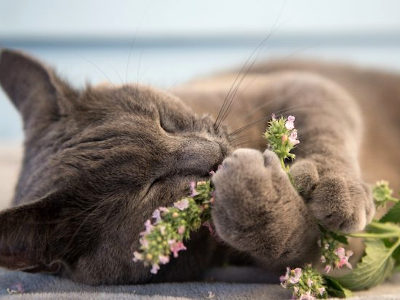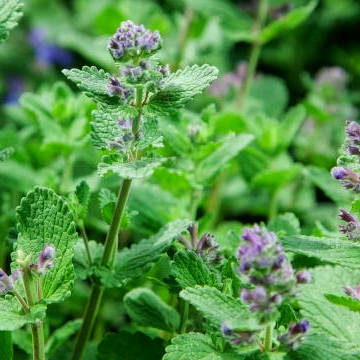Nepeta cataria, commonly known as catnip or catmint, is a perennial herb belonging to the mint family Lamiaceae. It has distinct characteristics, various uses, and benefits associated with it: Characteristics: 1. Fragrance and Appearance: Catnip is characterized by its aromatic leaves and small, tubular flowers. The leaves have a mint-like scent and are often gray-green in color, while the flowers can range from white to lavender. 2. Growth Habit: Catnip is a clump-forming herb that typically grows to a height of 2 to 3 feet (60 to 90 centimeters). It has a spreading nature and can quickly colonize an area if left unchecked. 3. Attracts Cats: Catnip contains a compound called nepetalactone, which is known to elicit a response in many domestic cats. It can stimulate cats, making them more active, playful, and sometimes even induce a state of relaxation. Not all cats are affected by catnip, and the sensitivity to its effects varies between individuals. Uses and Benefits: 1. Cat Enrichment: Catnip is commonly used as an enrichment tool for cats. It can be provided in various forms, such as dried leaves, cat toys stuffed with catnip, or sprays infused with catnip oil. These can be used to engage and entertain cats, encouraging exercise and mental stimulation. 2. Herbal Tea: Catnip leaves can be used to make a soothing herbal tea. The tea is known for its calming properties and has been used as a natural remedy to promote relaxation and relieve stress and anxiety. 3. Insect Repellent: Nepetalactone, the compound found in catnip, has been found to repel certain insects, including mosquitoes, flies, and cockroaches. Catnip oil can be used as a natural insect repellent or as an ingredient in homemade repellent sprays. 4. Medicinal Uses: Catnip has a long history of medicinal use. It has been used in traditional herbal medicine for various purposes, including relieving digestive discomfort, reducing fever, promoting sleep, and easing menstrual cramps. However, further research is needed to validate these claims and determine safe and effective uses. 5. Garden Plant: Catnip can be grown in gardens as an ornamental plant. Its attractive foliage and flowers can add beauty to flower beds, borders, or container gardens. Additionally, catnip can attract beneficial pollinators like bees and butterflies to the garden. 6. Companion Planting: Planting catnip in the garden can also serve as a natural pest deterrent. Its strong scent may help repel certain pests, such as aphids and squash bugs, from neighboring plants. It's important to note that while catnip is generally safe for cats and humans, individual sensitivities can vary. When using catnip products for cats, it's recommended to do so in moderation and observe the cat's response. Additionally, pregnant women should exercise caution when using catnip for medicinal purposes, as its effects on pregnancy are not well-studied.

